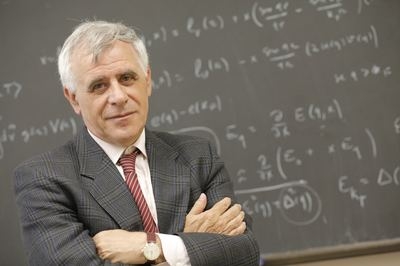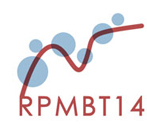| |
Feenberg Medal
2007 EUGENE FEENBERG AWARD
The International Advisory Committee of the series of International Conferences
on Recent Progress in Many-Body Theories is pleased to announce the award of the
2007 EUGENE FEENBERG MEMORIAL MEDAL IN MANY-BODY PHYSICS jointly to Professors
Stefano Fantoni and Eckhard Krotscheck.
Professors Fantoni and Krotscheck will receive this Medal for their work in providing a truly microscopic theory of strongly interacting quantum many-body systems. While working independently, they have made crucial contributions to the formal development of correlated wave functions and correlated basis theories. This award recognizes their pivotal and leading roles in advancing the correlated basis function (CBF) method, including the development of Fermi hypernetted chain (FHNC) theory, thereby providing an accurate, quantitative, microscopic description of energetics, structure, excitation and dynamical response of a dazzling array of physical many-body systems under realistic conditions of interaction, density, and temperature.
The Feenberg Award was established at the Third International Conference on Recent
Progress in Many-Body Theories in 1983 as a continuing memorial to Eugene Feenberg.
It commemorates his wise stewardship of a field that penetrates into all branches of
physics; his deep physical insights and great formal achievements; his dedicated
service as teacher and mentor; and the exemplary integrity of his personal and professional
life. The Feenberg Medal is normally awarded for work which is firmly established
and which can be demonstrated to have significantly advanced the field of many-body physics.
The current award will be presented at the 14th International Conference on Recent Progress
in Many-Body Theories, to be held in Barcelona, Spain, 16-20 July 2007.
Past Medal Recipients are David Pines (1985), John W. Clark (1987), Malvin H. Kalos (1989), Walter Kohn (1991), David M. Ceperley (1994), Lev P. Pitaevskii (1997), Anthony J. Leggett (1999), Philippe Nozières (2001), Spartak T. Belyaev and Lev P. Gor'kov (2004), and Raymond Bishop and Hermann Kümmel (2005).
CITATION
Professor Fantoni, Director of the International School for Advanced Studies (SISSA) in Trieste, Italy, is cited for

Stefano Fantoni
"His leading role in the development and extensive applications of the correlated basis function method, including the advance of Fermi hypernetted chain theory, thereby providing an accurate, quantitative, microscopic description of strongly-interacting quantum many-body systems, especially for finite atomic nuclei."
Professor Krotscheck, Head of the Theoretical Physics Institute at the Johannes Kepler Universität Linz, Austria, is cited for

Eckhard Krotscheck
"His leading role in the development and extensive applications of the correlated basis function method, including the advance of Fermi hypernetted chain theory, thereby providing an accurate, quantitative, microscopic description of strongly-interacting quantum many-body systems, especially for inhomogeneous quantum fluids."
Joint citation,
"For their leading role in the development and extensive applications of the correlated basis function method, including the advance of Fermi hypernetted chain theory, thereby providing an accurate, quantitative, microscopic description of a wide variety of strongly-interacting quantum many-body systems."
A brief biography of Professor Fantoni
Professor Stefano Fantoni received his PhD degree in 1971 from the Scuola Normale Superiore in Pisa under the supervision of Sergio Rosati. There followed a fruitful period (1971-86) in which he held an appointment as Associate Professor of Physics in Pisa, but also spent several long research stays abroad. These included visits to the Neils Bohr Institute in 1979 and the University of Köln in 1979, where he worked with Manfred Ristig. He spent two years (1981-82) as a Visiting Associate Professor at the University of Illinois-Urbana, establishing ties with the Urbana many-body group and returning for another extensive period in 1984. In 1986 he was named to a full professorship at the University Lecce, in Italy. In 1992 he moved to Trieste as a full Professor at SISSA, where he began to combine research with duties in scientific management, a mode of operation well suited to his quick mind, boundless energy, and consummate organizational skills. SISSA proved to be an ideal environment for this dual role. Professor Fantoni has served as Director of the Interdisciplinary Laboratory (1992-2000) and of the SISSA Master in Science Communication (1994-2000), becoming Director of SISSA in 2004.
Professor Fantoni has spearheaded the application of CBF and FHNC methods for the microscopic description of the structure and dynamics of nuclear matter and finite nuclei, as well as neutron-star matter. The determination of single-particle Green's functions and the longitudinal response of nuclear matter within the CBF framework have played an extremely important role in the theoretical interpretation of spectroscopic factors. He has worked with many distinguished and resourceful collaborators, starting with Sergio Rosati in the early days of the FHNC theory. It is worth mentioning his collaboration with the Urbana/Argonne group of Vijay Pandharipande and Bob Wiringa, and the continued work with Omar Benhar and Adelchi Fabrocini on the study of the nuclear response. Under Fantoni's leadership, SISSA has become a major center in many-body physics for both students and mature scientists. A recent result of this activity has emerged from the collaboration of Professor Fantoni with Kevin Schmidt, engaged in the creation and exploration of the Auxiliary Field Monte Carlo technique for Fermi systems.
Selected Publications of Professor Fantoni
- S. Fantoni and S. Rosati, Hypernetted-Chain Approximation for a Fermion System, Nuovo Cimento A 25, 593 (1975).
- S. Fantoni, Momentum Distribution of Boson and Fermion Systems in Jastrow Theory, Nuovo Cimento A 44, 191 (1978).
- O. Benhar, A. Fabrocini, and S. Fantoni, The Nuclear Spectral Function in Infinite Nuclear Matter, Nucl. Phys. A 505, 267 (1989).
- K. E. Schmidt and S. Fantoni, A Quantum Monte Carlo Method for Nucleon Systems, Phys. Lett. B 446, 99 (1999).
- A. Smerzi, S. Fantoni, S. Giovanazzi, and S. Shenoy, Quantum Coherent Atomic Tunneling between Two Trapped Bose-Einstein Condensates, Phys. Rev. Lett. 79, 4950 (1997).
A brief biography of Professor Krotscheck
After receiving his Diplom at the University of Köln in 1971, Professor Krotscheck began doctoral research in quantum many-body theory under the supervision of Manfred Ristig. From Köln, Krotscheck went on to an assistantship at the University of Hamburg, where he made the Habilitation transition in 1979. While also working with Wolfgang Kundt on problems in relativistic astrophysics, he continued to make innovative contributions to variational many-body theory. With the award of a Heisenberg Fellowship in 1980, he moved to the United States and spent extended periods at Stony Brook (with Gerry Brown), Urbana (with David Pines), and Santa Barbara (with Walter Kohn). Growing recognition of Krotscheck's impressive strengths as a many-body theorist led in 1984 to a faculty appointment at Texas A&M. In 1995, he was appointed to a chair in theoretical physics at the Johannes Kepler University of Linz, where he has created a major node in the world network of QMBT sites.
Professor Krotscheck has been the driving force in the development and applicatins of CBF and FHNC to numerous important systems throughout the past three decades. In the 1980's, in collaboration with Kohn and Qian, Professor Krotscheck produced a critically important series of papers that provided the basis for a general theory of inhomogeneous quantum-many body systems. In the nineties, collaborating with Mikko Saarela, he introduced explicitly time-dependent variational wave functions that allowed the direct determination of the density-density response function, and thus the dynamic structure function. His later applications of these works to liquid helium films, droplets and mixtures have won him wide acclaim from experimentalists the like of Robert Hallock, Peter Toennies, Paul Leiderer, Henri Godfrin and Hans-Jochen Lauter. More recently, he has been working on the improvement of computational density functional theory and the development of wave function based Euler-Lagrange theories in terms of a pair density functional theory. In parallel with his outstanding achievements in many-body theory, computational science, condensed-matter theory, and low-temperature physics, Professor Krotscheck has been an outstanding citizen of the respective research communities collaborating intensively in the organization of Many-Body Conferences and Schools.
Selected Publications of Professor Krotscheck
- E. Krotscheck and M. L. Ristig, Long Ranged Jastrow Correlations, Nucl. Phys. A 242, 389 (1975).
- E. Krotscheck, Effective Interactions, Linear Response, and Correlated Rings: A Study of Chain Diagrams in Correlated Basis Functions, Phys. Rev. A 26, 3536 (1982).
- E. Krotscheck, G. X. Qian, and W. Kohn, Theory of Inhomogeneous Quantum Systems I. Static Properties of Bose Fluids, Phys. Rev. B 31, 4245 (1985).
- E. Krotscheck, M. Saarela, K. Schörkhuber, and R. Zillich, Concentration Dependence of the Effective Mass of 3He Atoms in 3He-4He Mixtures, Phys. Rev. Lett. 80, 4709 (1998).
- E. Krotscheck and R. E. Zillich, The Dynamics of 4He Clusters, J. Chem. Phys. 115, 10161 (2001).
Call for nominations Feenberg Medal 2007
|
|



